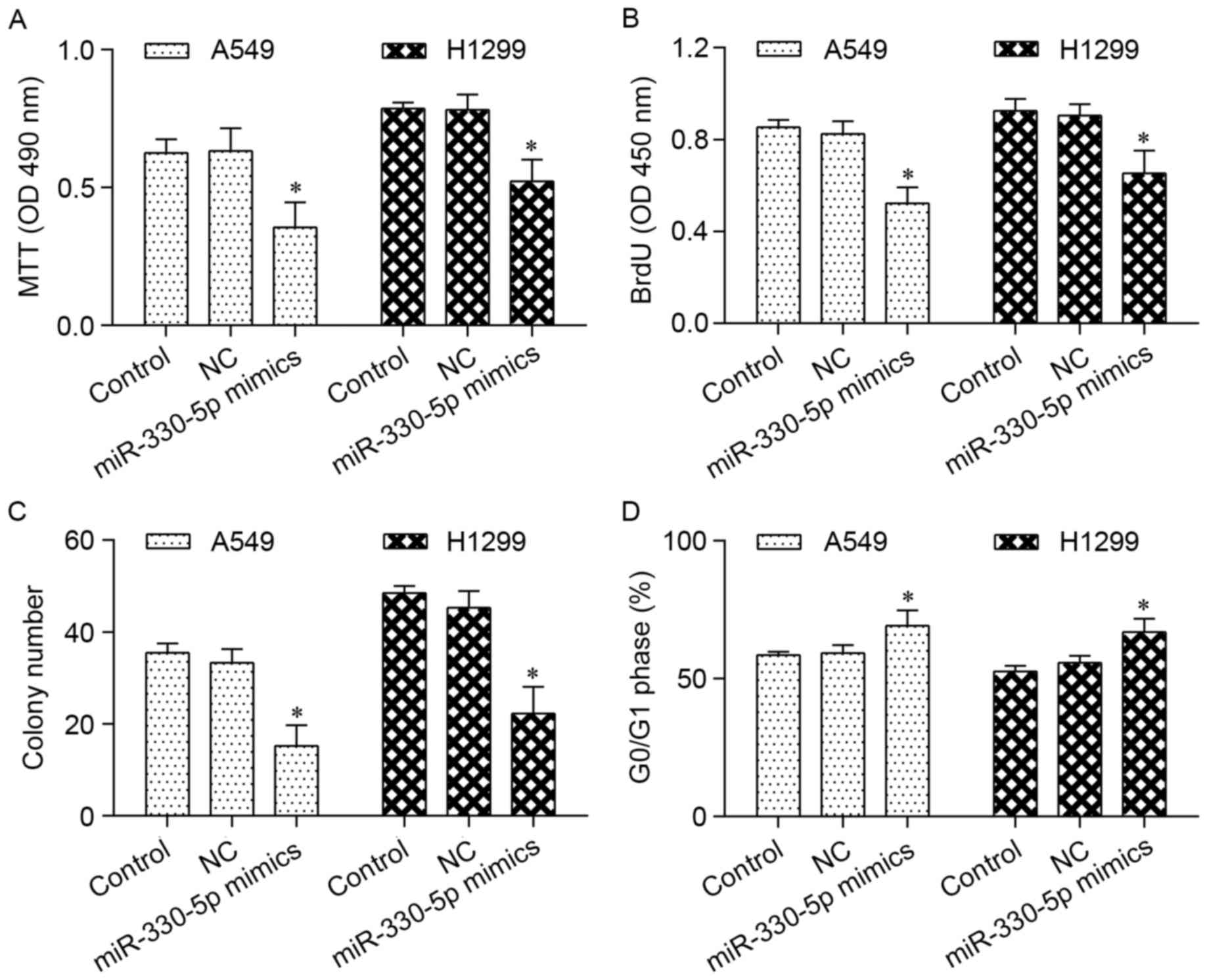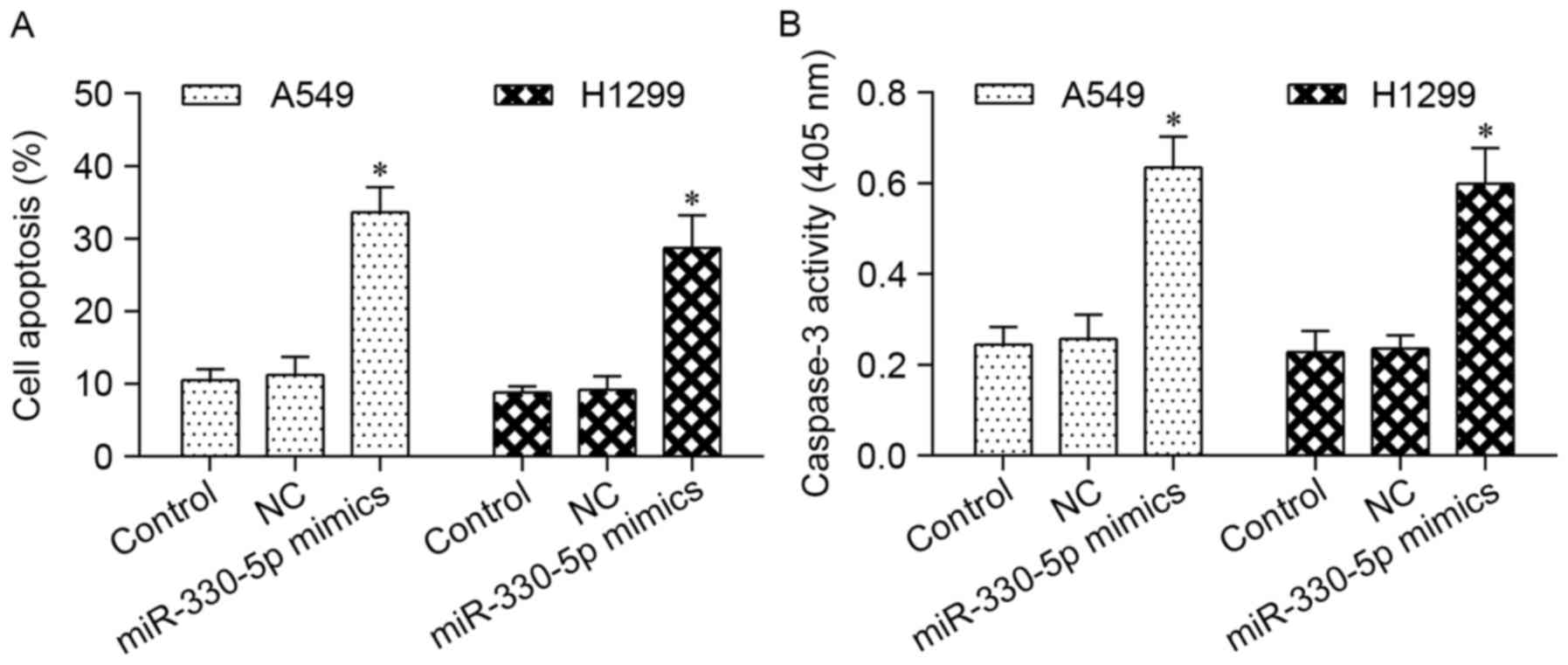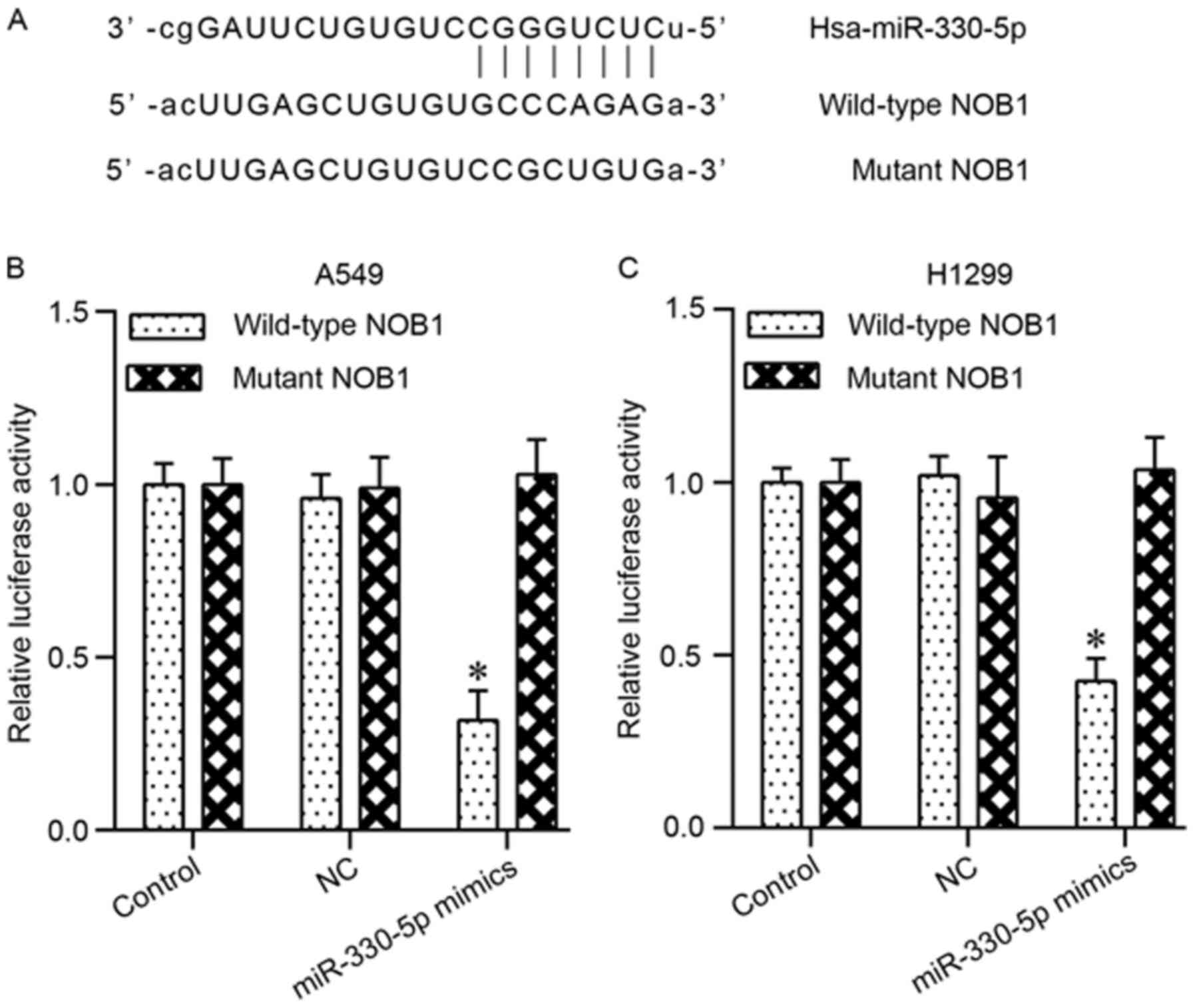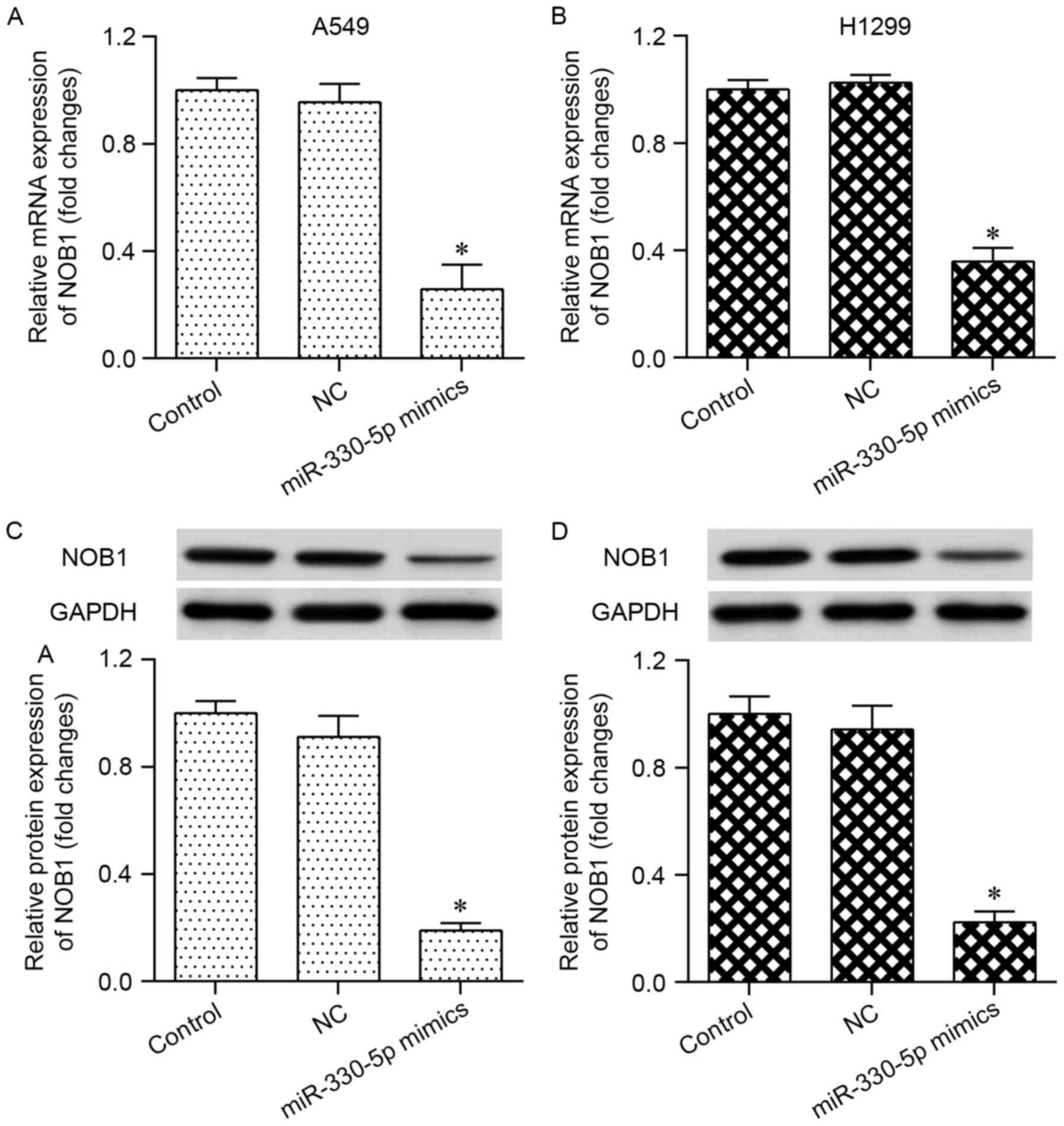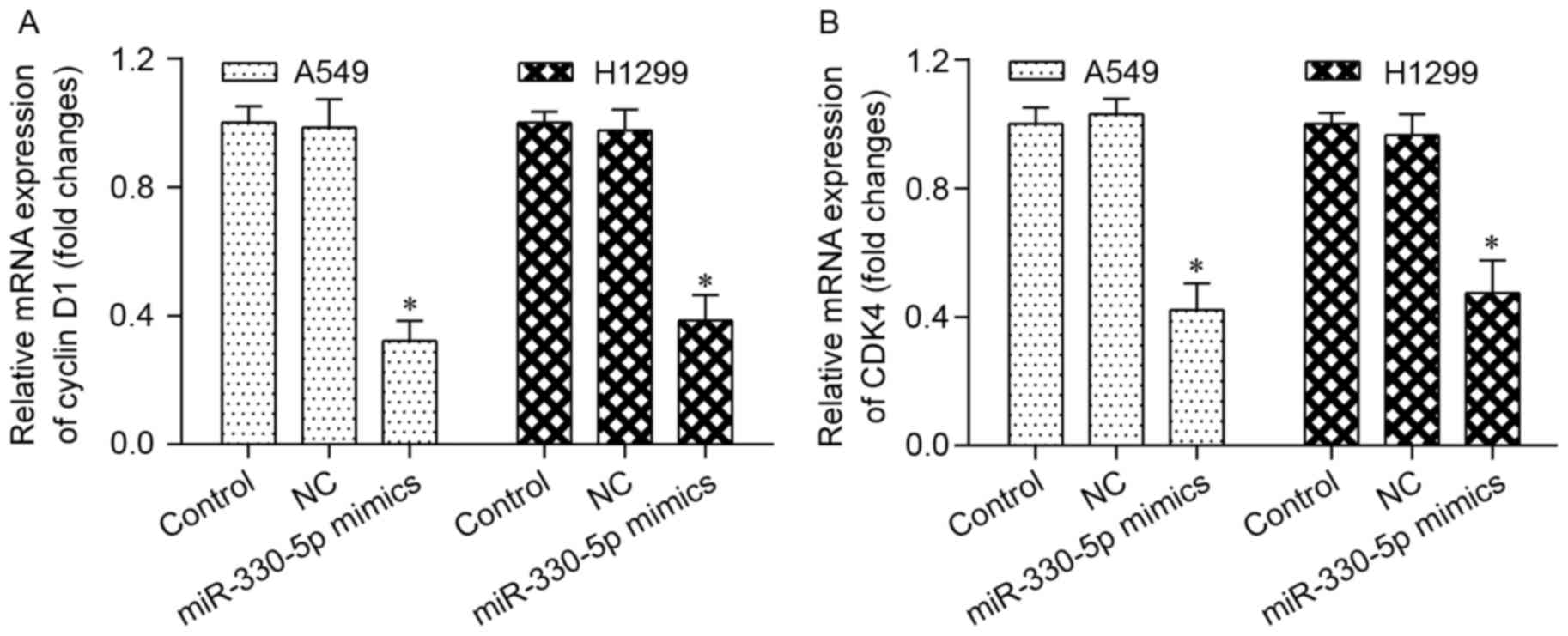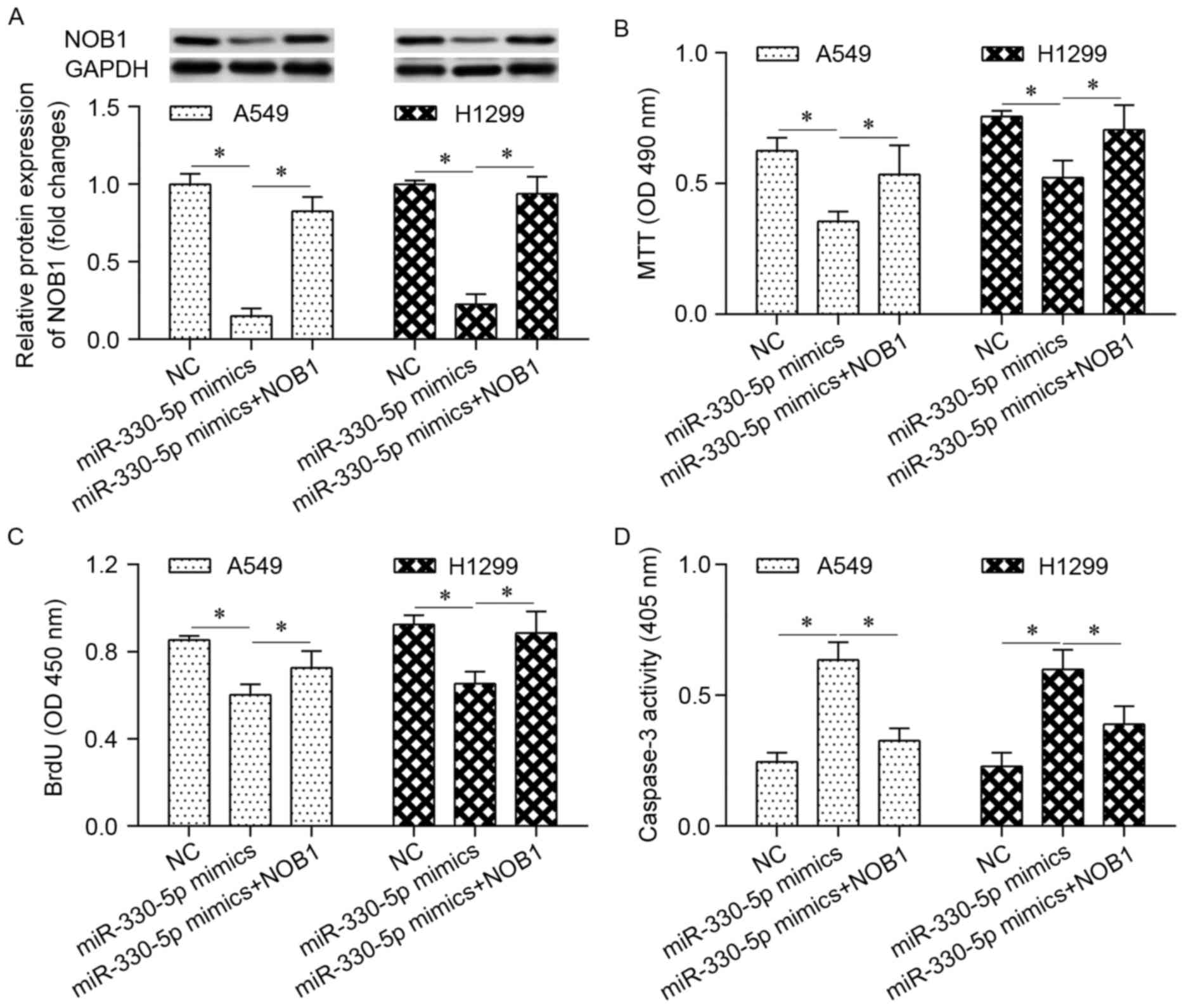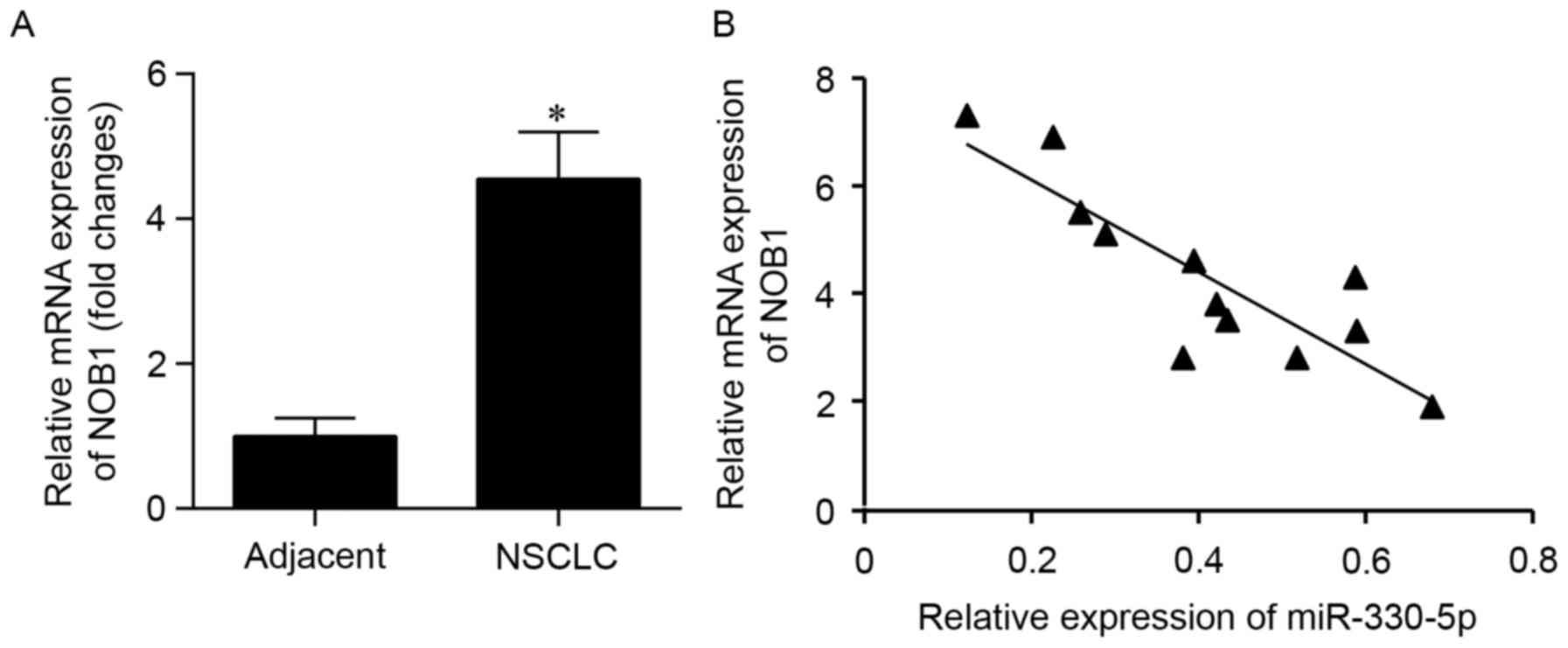Introduction
Lung cancer is the leading cause of
cancer-associated deaths worldwide (1). The majority of lung cancers are
non-small cell lung cancer (NSCLC), which accounts for
approximately 85–90% of all lung cancers (1). Although treatment strategies have been
advanced over the last few decades, the overall survival rate
remains extremely poor, with a 5-year overall survival of <15%
(2,3). However, the molecular pathogenesis of
NSCLC remains elusive. Therefore, it is crucial to gain a better
understanding of the mechanisms underlying NSCLC carcinogenesis to
help development of novel and promising diagnostic markers and
therapeutic targets.
MicroRNAs (miRNAs) are small non-coding RNA
molecules that can target the 3′-untranslated region (3′-UTR) of
target mRNA to inhibit protein translation (4,5).
miRNAs have emerged as critical regulators in many diseases,
including cancer (6). Aberrantly
expressed miRNAs have been suggested to harbor diagnostic,
prognostic and therapeutic implications in cancer (7,8).
miRNAs play an important role in various life activities, including
development, metabolism, differentiation, proliferation and
apoptosis (9). To date, various
miRNAs have been found to be dysregulated in NSCLC and participate
in the tumorigenesis of NSCLC (10,11).
Therefore, miRNAs may serve as promising therapeutic targets in
NSCLC treatment.
In recent years, the NIN1/RPN12 binding protein 1
homologue (NOB1) has been recognized as an oncogene in many types
of human cancers (12,13). NOB1 is located on chromosome 16q22.1
and consists of nine exons and eight introns encoding a 50 KDa
protein which is a subunit of the 26 S proteasome (14). NOB1 regulates protease functions and
RNA metabolism (15). NOB1 is
expressed in various tissues and organs and is mainly distributed
in the nucleus (14,15). However, the dysregulation of NOB1 is
associated with tumorigenesis in various cancers, including
hepatocellular carcinoma (16),
glioma (17) and prostate cancer
(18). High expression of NOB1 is
associated with cancer cell proliferation, migration and invasion
(18,19). Studies have shown that high
expression of NOB1 in NSCLC is related with tumor node metastasis
stage, histopathological grade and lymph node metastasis (20,21).
Silencing of NOB1 inhibits NSCLC cell proliferation in vitro
and in vivo (6,22). Therefore, NOB1 may serve as a
potential therapeutic target for NSCLC.
Previous studies have documented the critical role
of miR-330-5p in regulating cell proliferation, migration and
invasion of many cancer types (23,24).
However, the potential role of miR-330-5p in NSCLC has still not
been documented. In the present study, we investigated the
potential role of miR-330-5p in NSCLC. Our results suggest that
miR-330-5p inhibits NSCLC cell growth by downregulating NOB1
expression. Our study suggests that miR-330-5p is a tumor
suppressor in NSCLC and has the potential to be a therapeutic
target for NSCLC treatment.
Materials and methods
Patient specimens
NSCLC tumor samples and paired adjacent normal lung
tissue samples were obtained from twelve NSCLC patients undergoing
primary surgical resection at the Second Affiliated Hospital of
Medical School, Xi'an Jiaotong University. The resected tissues
were immediately frozen in liquid nitrogen at −80°C. The patients
that participated in this study provided signed informed consent.
This study was approved by Institutional Human Experiment and
Ethics Committee of the Second Affiliated Hospital of Medical
School, Xi'an Jiaotong University and was conducted in accordance
with the Helsinki Declaration.
Cell lines
Human NSCLC cell lines including A549, H1299, H1975
and NCI-H1264, and the normal human lung cell line BEAS-2B were
purchased from American Type Culture Collection (ATCC, Manassas,
VA, USA). The cells were cultured in Dulbecco's modified Eagle's
medium (DMEM; Gibco, Rockville, MD, USA) containing 10% fetal
bovine serum plus with 1% penicillin/streptomycin (Sigma, St.
Louis, MO, USA). Cells were routinely grown in a humidified
atmosphere containing 5% CO2 at 37°C.
Cell transfection
The miR-330-5p mimics and negative control (NC) were
purchased from GenePharma (Shanghai, China) and transfected into
cells using Lipofectamine 2000 (Invitrogen, Carlsbad, CA, USA). The
cDNA of NOB1 without 3′-UTR was inserted into pcDNA3 plasmid that
was transfected into cells using Lipofectamine 2000
(Invitrogen).
Real-time quantitative polymerase
chain reaction (RT-qPCR)
Total RNA from tissues or cells was extracted using
TRIzol reagent (Invitrogen) as per the manufacturer's instructions.
First-strand cDNA was synthesized using the MMLV Reverse
Transcriptase (for mRNA detection) or miRcute miRNA cDNA kit
(Tiangen, Beijing, China). RT-qPCR was performed with the SYBR
Green PCR kit (Applied Biosystems, Foster City, CA, USA) and
specific primers in the ABI7500 Real-time PCR system (Applied
Biosystems). GAPDH and U6 served as internal controls. Data were
calculated using the 2−∆∆Ct method. Fold changes in gene
expression were obtained by normalization to the control group.
3-(4,5-Dimethylthiazol-2-yl)-2,5-diphenyltetrazolium bromide (MTT)
assay
Cells were plated into 96-well plates at a density
of 1×104 cells/well and cultured overnight. After
transfection with miR-330-5p mimics for 72 h, cells were treated
with 20 µl of MTT (5 mg/ml; Sigma) for 4 h. The formazan crystals
were solubilized in 200 µl of dimethyl sulfoxide (Sigma). The
absorbance at 490 nm was measured with a microplate reader
(Bio-Rad, Hercules, CA, USA).
Bromodeoxyuridine (BrdU) assay
The BrdU assay was performed using a BrdU cell
proliferation assay kit (Cell Signaling Technology, Danvers, MA,
USA) according to the manufacturer's instructions. Briefly, cells
were plated into 96-well plates at a density of 1×104
cells/well and transfected with miR-330-5p mimics for 48 h. Then,
cells were treated with 10 µl of BrdU solution for 2 h followed by
incubation with 150 µl of denaturing solution. Afterwards,
peroxidase conjugated anti-BrdU (1:1,000) was added and incubated
for 90 min at room temperature. At the end of the incubation
period, the solution was discarded and cells were washed with 200
µl of washing buffer. Finally, 100 µl of substrate solution was
added and incubated for 15 min. The absorbance at 450 nm was
measured with a microplate reader (Bio-Rad).
Colony formation assay
Cells transfected with miR-330-5p mimics for 48 h
were diluted in 0.33% low-melting agarose and seeded into 6-well
plates (1,000 cells/well) on the bottom of 0.5% agar layer. After
growing for 2 weeks, the colonies were fixed with methanol for 30
min and then stained with 0.1% crystal violet (Sigma). Then, the
visible colonies were counted under a microscope (Olympus, Tokyo,
Japan).
Cell cycle assay
After synchronization by serum-starvation for 24 h,
cells were transfected with miR-330-5p mimics for 48 h. Then, cells
were harvested, digested with trypsin and washed with ice-cold
phosphate buffered saline (PBS). After fixation with 70% ethanol at
4°C overnight, cells were treated with 50 µg/ml RNase A for 30 min
at room temperature. Then, cells were treated with 50 µg/ml of
propidium iodide (PI) for 30 min in the dark. Cell cycle
distribution was analyzed by FACS (BD Biosciences, San Jose, CA,
USA).
Annexin V/PI apoptosis assay
Apoptosis was detected using an Annexin V-FITC/PI
kit (Beyotime Biotechnology, Haimen, China) according to the
manufacturer's instructions. Briefly, cells were transfected with
miR-330-5p mimics for 48 h and then harvested. Cells were digested
by trypsin and washed with PBS. Cells were re-suspended in 500 µl
of binding buffer containing 1.25 µl of Annexin V-FITC and 10 µl of
PI for 20 min in the dark. Cells were then assessed by a BD flow
cytometer (BD Biosciences).
Caspase-3 activity assay
Capase-3 activity was detected using a caspase-3
activity assay (Beyotime Biotechnology). Briefly, after cells were
transfected with miR-330-5p mimics for 48 h cells, cells were
harvested, lysed and incubated with Ac-DEVD-pNA for 2 h at 37°C.
The absorbance at 405 nm was determined using a microplate reader
(Bio-Rad).
Dual-luciferase reporter assay
The 3′-UTR of NOB1 containing the wild-type or
mutant binding sites of miR-330-5p were inserted into the pmirGLO
vector (Promega, Madison, WI, USA) following by transfection into
A549 and H1299 cells along with miR-330-5p mimics using
Lipofectamine 2000 (Invitrogen). After 48 h, the relative
luciferase activity was detected by a dual-luciferase assay kit
(Promega).
Western blot analysis
Total protein was extracted using RIPA buffer and
the protein concentration was measured using a BCA kit (Beyotime
Biotechnology). An equal amount of protein (50 µg) was loaded onto
a sodium dodecyl sulfate polyacrylamide gel for separation. The
separated proteins were transferred to a polyvinylidene fluoride
membrane (Millipore, Boston, MA, USA). The membrane was then
blocked using 5% non-fat milk for 1 h at 37°C followed by
incubation with primary antibodies (anti-NOB1 and anti-GAPDH;
Abcam, Cambridge, UK) with appropriate concentrations at 4°C
overnight. Then, the membrane was probed with horseradish
peroxidase conjugated secondary antibodies (1:1,000, Beyotime
Biotechnology) for 1 h at 37°C. The immunoreactive proteins were
developed by using enhanced chemiluminescence system (Millipore).
The intensity of the protein blots on the membrane was analyzed by
Image-Pro Plus 6.0 software (Media Cybernetics, Inc., Rockville,
MD, USA).
Data analysis
All results were depicted as means ± standard
deviation and the statistical analyses were conducted by SPSS
version 18.0 software (SPSS Inc., Chicago, IL, USA). Differences
were analyzed by Student's t-test or one-way analysis of variance
with a Bonferroni correction. Correlation analysis were performed
by Spearman's correlation analysis. Differences were regarded as
statistically significant at P<0.05.
Results
miR-330-5p is downregulated in NSCLC
tissues and cell lines
To investigate the potential role of miR-330-5p on
the progression of NSCLC, we first examined the expression of
miR-330-5p expression in NSCLC tissues by RT-qPCR. The results
showed that miR-330-5p was significantly decreased in NSCLC tissues
compared with adjacent normal lung tissues (Fig. 1A). Moreover, we detected miR-330-5p
expression in NSCLC cell lines including A549, H1299, H1975 and
NCI-H1264. The results showed that miR-330-5p was markedly
decreased in NSCLC cell lines compared with the normal lung cell
line BEAS-2B (Fig. 1B). Taken
together, these results suggest that miR-330-5p may be involved in
the development and progression of NSCLC.
Overexpression of miR-330-5p inhibits
cell growth of NSCLC cells
To investigate the exact biological function of
miR-330-5p in NSCLC, we overexpressed miR-330-5p in A549 and H1299
cells by transfection with miR-330-5p mimics. We then detected the
effect of miR-330-5p overexpression on cell growth of NSCLC cells
by MTT, BrdU, colony formation and cell cycle assays. The MTT assay
showed that overexpression of miR-330-5p significantly reduced the
viability of A549 and H1299 cells (Fig.
2A). The BrdU assay showed that miR-330-5p overexpression
markedly inhibited the proliferation of A549 and H1299 cells
(Fig. 2B). Moreover, the
colony-forming capacity of A549 and H1299 cells was also
significantly decreased by miR-330-5p overexpression (Fig. 2C). In addition, overexpression of
miR-330-5p significantly induced cell cycle arrest in G0/G1 phase
(Fig. 2D). Overall, these results
suggest that miR-330-5p suppresses NSCLC cell growth.
Overexpression of miR-330-5p promotes
apoptosis of NSCLC cells
To further investigate the biological function of
miR-330-5p in NSCLC, we assessed the effect of miR-330-5p
overexpression on NSCLC cell apoptosis by Annexin V/PI apoptosis
assay and caspase-3 activity assay. The Annexin V/PI apoptosis
assay showed that overexpression of miR-330-5p significantly
induced apoptosis in NSCLC cells (Fig.
3A). Furthermore, caspase-3 activity was markedly increased by
miR-330-5p overexpression (Fig.
3B). These results suggest that miR-330-5p promotes apoptosis
in NSCLC cells.
NOB1 is a target gene of miR-330-5p in
NSCLC cells
To investigate the underlying mechanism of
miR-330-5p in regulating NSCLC cell growth, we performed
bioinformatics analysis to predict the potential target genes of
miR-330-5p. Interestingly, we found that NOB1 was a potential
target gene of miR-330-5p (Fig.
4A). To investigate whether miR-330-5p directly binds to NOB1
3′-UTR, we performed dual luciferase reporter assays. The results
showed that luciferase activity in the luciferase reporter vector
containing the NOB1 3′-UTR was significantly reduced by
overexpression of miR-330-5p (Fig. 4B
and C). However, this inhibitory effect of miR-330-5p
overexpression on luciferase activity was abolished by mutating
binding sites in the NOB1 3′-UTR (Fig.
4B and C). Furthermore, we detected a direct regulatory effect
of miR-330-5p on NOB1 expression by RT-qPCR and western blot
analysis. The results showed that the mRNA (Fig. 5A and B) and protein (Fig. 5C and D) expression levels of NOB1
were significantly decreased with miR-330-5p overexpression in A549
and H1299 cells. Taken together, these results indicate that NOB1
is a target gene of miR-330-5p in NSCLC cells.
Overexpression of miR-330-5p inhibits
the expression of cyclin D1 and cyclin-dependent kinase 4
(CDK4)
Previous studies have reported that NOB1 regulates
NSCLC cell growth associated with regulating cyclin D1 and CDK4
(22). Considering the effect of
miR-330-5p on NOB1 expression, we speculated that miR-330-5p may
regulate the expression of cyclin D1 and CDK4. To test this
hypothesis, we measured the effect of miR-330-5p overexpression on
mRNA expression of cyclin D1 and CDK4 by RT-qPCR. The results
showed that the expression of cyclin D1 (Fig. 6A) and CDK4 (Fig. 6B) was significantly reduced by
miR-330-5p overexpression, implying that miR-330-5p regulates the
expression of cyclin D1 and CDK4.
miR-330-5p inhibits NSCLC cell growth
by targeting NOB1
To further investigate whether miR-330-5p inhibits
NSCLC cell growth by targeting NOB1, the pcDNA3-NOB1 vector and
miR-330-5p mimics were cotransfected into A549 and H1299 cells. The
results showed that NOB1 expression was significantly increased in
cells cotransfected with the pcDNA3-NOB1 vector and miR-330-5p
mimics compared with cells transfected with miR-330-5p mimics only
(Fig. 7A). Moreover, the inhibitory
effect of miR-330-5p on NSCLC cell growth was significantly
reversed by NOB1 overexpression. (Fig.
7B and C). NOB1 overexpression also markedly abrogated
miR-330-5p-induced NSCLC cell apoptosis (Fig. 7D). Collectively, these results
suggests miR-330-5p suppresses cell growth and induces apoptosis by
inhibiting NOB1 in NSCLC cells.
miR-330-5p expression is inversely
correlated with NOB1 mRNA expression in NSCLC tissues
To further confirm the relevance of miR-330-5p/NOB1
in the progression of NSCLC, we analyzed the correlation between
miR-330-5p expression and NOB1 mRNA expression in NSCLC tissues by
RT-qPCR. The results showed that NOB1 mRNA was highly expressed in
NSCLC tissues (Fig. 8A).
Correlation analysis showed that miR-330-5p expression was
inversely correlated with NOB1 mRNA expression in NSCLC tissues
(Fig. 8B). The data indicate that
decreased miR-330-5p expression may contribute to the increased
expression of NOB1 in NSCLC.
Discussion
Increasing evidence suggests that miRNAs play
important roles in the development and progression of NSCLC by
regulating oncogenes or tumor suppressive genes (25–27).
However, the precise roles of miRNAs in NSCLC remains largely
unknown. In this study, we demonstrated that miR-330-5p was a novel
NSCLC-associated miRNA. We found that miR-330-5p was decreased in
NSCLC and overexpression of miR-330-5p inhibited NSCLC cell growth.
Our study indicates that miR-330-5p may play an important role in
the development of NSCLC.
In recent years, miR-330-5p has been reported as an
important regulator in many pathological processes. Dysregulated
miR-330-5p is found in peripheral whole blood of bipolar disorder
patients (28). miR-330-5p is
involved in regulating plasticity, learning and memory (29). miR-330-5p is highly upregulated in
bone marrow-derived human mesenchymal stem cells during cellular
senescence (30). miR-330-5p
regulates depigmentation through targeting tyrosinase (31). Studies have shown that miR-330-5p
inhibits proliferation keratinocytes by targeting protein
disulfide-isomerase A3 (32) and
signal recognition particle receptor α (33). miR-330-5p inhibits cell
proliferation and invasion of cutaneous malignant melanoma cells
through the downregulation of tyrosinase and protein
disulfide-isomerase A3 (34).
miR-330-5p represses pancreatic cancer cell proliferation,
migration and invasion as well as sensitizes pancreatic cancer
cells to gemcitabine through targeting mucin 1 (24). miR-330-5p strongly inhibits the
expression of T cell immunoglobulin and mucin domain-3 in acute
myeloma leukemia cells (35).
Downregulated miR-330-5p expression has been found in colorectal
cancer; miR-330-5p overexpression represses colorectal cancer
development by targeting integrin α5 (36). Moreover, miR-330-5p has been
reported as an important modulator of neoadjuvant chemoradiotherapy
sensitivity in esophageal adenocarcinoma (37). These studies suggest a tumor
suppressive role of miR-330-5p. In this study, we demonstrated that
miR-330-5p was decreased in NSCLC and overexpression of miR-330-5p
inhibited NSCLC cell growth, further supporting a tumor suppressive
role of miR-330-5p.
NOB1 has been found to be highly expressed in many
types of cancers, including ovarian cancer (13), papillary thyroid carcinoma (17), glioma (12), prostate cancer (38), colon cancer (39) and oral squamous cell carcinoma
(40). Silencing of NOB1 by short
hairpin RNA (shRNA) or small interfering RNA (siRNA) exhibits
considerable antitumor effects (12,13,39–42).
Studies have shown that high expression of NOB1 in NSCLC is related
to histopathological grade, tumor node metastasis stage and lymph
node metastasis (20,21). High expression of NOB1 is associated
with a poor early response to cisplatin-based chemotherapy in
advanced NSCLC patients (43).
Simultaneously determining the expression of NOB1 and right open
reading frame kinase 2 can improve the diagnostic rate in early
stages of NSCLC (44). Knockdown of
NOB1 by shRNA has been shown to inhibit cell proliferation and
tumor growth in NSCLC, both in vivo and in vitro
(6). Lentivirus-mediated gene
silencing of NOB1 inhibits cell growth and induced cell cycle
arrest associated with inhibition of cyclin D1 and CDK4 (22). These findings indicate that NOB1 may
serve as a promising target for NSCLC treatment. In this study, we
identified NOB1 as a target gene of miR-330-5p. We showed that
inhibition of NOB1 by miR-330-5p overexpression repressed NSCLC
cell growth and the expression of cyclin D1 and CDK4. We also
showed that NOB1 mRNA expression was conversely correlated with
miR-330-5p expression in NSCLC tissues. Decreased expression of
miR-330-5p may contribute to increased expression of NOB1 in NSCLC
and may be associated with NSCLC tumorigenesis.
In addition to shRNA and siRNA, miRNAs can be used
for modulating NOB1 expression. Several studies have reported that
miR-326 functions as a tumor suppressor by targeting NOB1 and
inhibiting NOB1 expression in glioma (45), colorectal cancer (46) and gastric cancer (47). Downregulated miR-646 correlates with
tumor metastasis of clear cell renal carcinoma by promoting NOB1
expression (48). miR-192 inhibits
the tumorigenicity of prostate cancer cells by targeting NOB1
(49). Moreover, Huang et al
have reported that miR-139-3p targets NOB1 to induce apoptosis and
inhibit metastasis in cervical cancer (50). Our study suggests that miR-330-5p is
a novel regulator of NOB1. miR-330-5p may serve as a potential
target for the development of miRNA-based therapy for NSCLC
treatment by targeting NOB1.
In summary, our results show that miR-139-5p
inhibits NSCLC cell growth by targeting NOB1. Decreased miR-330-5p
expression was correlated with high expression of NOB1 in NSCLC,
implying that miR-330-5p/NOB1 plays an important role in the
development and progression of NSCLC. Our study suggests that
miR-330-5p is a candidate tumor suppressor in NSCLC. Inhibiting
NOB1 via miR-330-5p may serve as a promising therapeutic strategy
for the treatment of NSCLC.
Glossary
Abbreviations
Abbreviations:
|
miRNAs
|
microRNAs
|
|
NSCLC
|
non-small cell lung cancer
|
|
NOB1
|
NIN/RPN12 binding protein 1
|
|
CDK4
|
cyclin-dependent kinase 4
|
|
RT-qPCR
|
real-time quantitative polymerase
chain reaction
|
|
MTT
|
3-(4,5-dimethylthiazol-2-yl)-2,5-diphenyltetrazolium bromide
|
|
BrdU
|
bromodeoxyuridine
|
|
PBS
|
phosphate buffered saline
|
|
PI
|
propidium iodide
|
|
3′-UTR
|
3′-untranslated region
|
References
|
1
|
Siegel RL, Miller KD and Jemal A: Cancer
statistics, 2016. CA Cancer J Clin. 66:7–30. 2016. View Article : Google Scholar : PubMed/NCBI
|
|
2
|
Claassens L, van Meerbeeck J, Coens C,
Quinten C, Ghislain I, Sloan EK, Wang XS, Velikova G and Bottomley
A: Health-related quality of life in non-small-cell lung cancer: An
update of a systematic review on methodologic issues in randomized
controlled trials. J Clin Oncol. 29:2104–2120. 2011. View Article : Google Scholar : PubMed/NCBI
|
|
3
|
Hu Z, Chen X, Zhao Y, Tian T, Jin G, Shu
Y, Chen Y, Xu L, Zen K, Zhang C, et al: Serum microRNA signatures
identified in a genome-wide serum microRNA expression profiling
predict survival of non-small-cell lung cancer. J Clin Oncol.
28:1721–1726. 2010. View Article : Google Scholar : PubMed/NCBI
|
|
4
|
Bartel DP: MicroRNAs: Genomics,
biogenesis, mechanism, and function. Cell. 116:281–297. 2004.
View Article : Google Scholar : PubMed/NCBI
|
|
5
|
Winter J, Jung S, Keller S, Gregory RI and
Diederichs S: Many roads to maturity: microRNA biogenesis pathways
and their regulation. Nat Cell Biol. 11:228–234. 2009. View Article : Google Scholar : PubMed/NCBI
|
|
6
|
Li Y, Ma C, Qian M, Wen Z, Jing H and Qian
D: Downregulation of NOB1 suppresses the proliferation and tumor
growth of non-small cell lung cancer in vitro and in
vivo. Oncol Rep. 31:1271–1276. 2014. View Article : Google Scholar : PubMed/NCBI
|
|
7
|
Mahdian-Shakib A, Dorostkar R, Tat M,
Hashemzadeh MS and Saidi N: Differential role of microRNAs in
prognosis, diagnosis, and therapy of ovarian cancer. Biomed
Pharmacother. 84:592–600. 2016. View Article : Google Scholar : PubMed/NCBI
|
|
8
|
Nassar FJ, Nasr R and Talhouk R: MicroRNAs
as biomarkers for early breast cancer diagnosis, prognosis and
therapy prediction. Pharmacol Ther. 172:34–49. 2017. View Article : Google Scholar : PubMed/NCBI
|
|
9
|
Kim VN: MicroRNA biogenesis: Coordinated
cropping and dicing. Nat Rev Mol Cell Biol. 6:376–385. 2005.
View Article : Google Scholar : PubMed/NCBI
|
|
10
|
Li S, Gao M, Li Z, Song L, Gao X, Han J,
Wang F, Chen Y, Li W, Yang J, et al: Role of microRNAs in
metastasis of non-small cell lung cancer. Front Biosci (Landmark
Ed). 21:998–1005. 2016. View
Article : Google Scholar : PubMed/NCBI
|
|
11
|
Feng B, Zhang K, Wang R and Chen L:
Non-small-cell lung cancer and miRNAs: Novel biomarkers and
promising tools for treatment. Clin Sci (Lond). 128:619–634. 2015.
View Article : Google Scholar : PubMed/NCBI
|
|
12
|
Wang H, Li P and Zhao B: Knockdown of NOB1
expression by RNAi inhibits cellular proliferation and migration in
human gliomas. Gene. 528:146–153. 2013. View Article : Google Scholar : PubMed/NCBI
|
|
13
|
Lin Y, Peng S, Yu H, Teng H and Cui M:
RNAi-mediated downregulation of NOB1 suppresses the growth and
colony-formation ability of human ovarian cancer cells. Med Oncol.
29:311–317. 2012. View Article : Google Scholar : PubMed/NCBI
|
|
14
|
Zhang Y, Ni J, Zhou G, Yuan J, Ren W, Shan
Y, Tang W, Yu L and Zhao S: Cloning, expression and
characterization of the human NOB1 gene. Mol Biol Rep. 32:185–189.
2005. View Article : Google Scholar : PubMed/NCBI
|
|
15
|
Veith T, Martin R, Wurm JP, Weis BL,
Duchardt-Ferner E, Safferthal C, Hennig R, Mirus O, Bohnsack MT,
Wöhnert J, et al: Structural and functional analysis of the
archaeal endonuclease Nob1. Nucleic Acids Res. 40:3259–3274. 2012.
View Article : Google Scholar : PubMed/NCBI
|
|
16
|
Lu Z, Guo Q, Shi A, Xie F and Lu Q:
Downregulation of NIN/RPN12 binding protein inhibit the growth of
human hepatocellular carcinoma cells. Mol Biol Rep. 39:501–507.
2012. View Article : Google Scholar : PubMed/NCBI
|
|
17
|
Lin S, Meng W, Zhang W, Liu J, Wang P, Xue
S and Chen G: Expression of the NOB1 gene and its clinical
significance in papillary thyroid carcinoma. J Int Med Res.
41:568–572. 2013. View Article : Google Scholar : PubMed/NCBI
|
|
18
|
Zhang X, Zhang D, Qu F, Hong Y, Cao J, Pan
X, Li L, Huang Y, Huang H, Yin L, et al: Knockdown of NOB1
expression inhibits the malignant transformation of human prostate
cancer cells. Mol Cell Biochem. 396:1–8. 2014. View Article : Google Scholar : PubMed/NCBI
|
|
19
|
Chen B, Liu J, Wu D, Qin Y, Peng C, Li C
and Wang J: Gene silencing of NOB1 by lentivirus suppresses growth
and migration of human osteosarcoma cells. Mol Med Rep.
9:2173–2179. 2014. View Article : Google Scholar : PubMed/NCBI
|
|
20
|
Liu K, Chen HL, Gu MM and You QS:
Relationship between NOB1 expression and prognosis of resected
non-small cell lung cancer. Int J Biol Markers. 30:e43–e48. 2015.
View Article : Google Scholar : PubMed/NCBI
|
|
21
|
Liu K, Gu MM, Chen HL and You QS: NOB1 in
non-small-cell lung cancer: Expression profile and clinical
significance. Pathol Oncol Res. 20:461–466. 2014. View Article : Google Scholar : PubMed/NCBI
|
|
22
|
Huang W, Zhong W, Xu J, Su B, Huang G, Du
J and Liu Q: Lentivirus-mediated gene silencing of NOB1 suppresses
non-small cell lung cancer cell proliferation. Oncol Rep.
34:1510–1516. 2015. View Article : Google Scholar : PubMed/NCBI
|
|
23
|
Yiwei T, Hua H, Hui G, Mao M and Xiang L:
HOTAIR interacting with MAPK1 regulates ovarian cancer SKOV3 cell
proliferation, migration, and invasion. Med Sci Monit.
21:1856–1863. 2015. View Article : Google Scholar : PubMed/NCBI
|
|
24
|
Tréhoux S, Lahdaoui F, Delpu Y, Renaud F,
Leteurtre E, Torrisani J, Jonckheere N and Van Seuningen I:
Micro-RNAs miR-29a and miR-330-5p function as tumor suppressors by
targeting the MUC1 mucin in pancreatic cancer cells. Biochim
Biophys Acta. 1853:2392–2403. 2015. View Article : Google Scholar : PubMed/NCBI
|
|
25
|
Hu H, Xu Z, Li C, Xu C, Lei Z, Zhang HT
and Zhao J: MiR-145 and miR-203 represses TGF-β-induced
epithelial-mesenchymal transition and invasion by inhibiting SMAD3
in non-small cell lung cancer cells. Lung Cancer. 97:87–94. 2016.
View Article : Google Scholar : PubMed/NCBI
|
|
26
|
Sun CC, Li SJ and Li DJ: Hsa-miR-134
suppresses non-small cell lung cancer (NSCLC) development through
down-regulation of CCND1. Oncotarget. 7:35960–35978. 2016.
View Article : Google Scholar : PubMed/NCBI
|
|
27
|
Chen W, Wang J, Liu S, Wang S, Cheng Y,
Zhou W, Duan C and Zhang C: MicroRNA-361-3p suppresses tumor cell
proliferation and metastasis by directly targeting SH2B1 in NSCLC.
J Exp Clin Cancer Res. 35:762016. View Article : Google Scholar : PubMed/NCBI
|
|
28
|
Maffioletti E, Cattaneo A, Rosso G, Maina
G, Maj C, Gennarelli M, Tardito D and Bocchio-Chiavetto L:
Peripheral whole blood microRNA alterations in major depression and
bipolar disorder. J Affect Disord. 200:250–258. 2016. View Article : Google Scholar : PubMed/NCBI
|
|
29
|
Cohen JE, Lee PR and Fields RD: Systematic
identification of 3′-UTR regulatory elements in activity-dependent
mRNA stability in hippocampal neurons. Philos Trans R Soc Lond B
Biol Sci. 369:3692014. View Article : Google Scholar
|
|
30
|
Yoo JK, Kim CH, Jung HY, Lee DR and Kim
JK: Discovery and characterization of miRNA during cellular
senescence in bone marrow-derived human mesenchymal stem cells. Exp
Gerontol. 58:139–145. 2014. View Article : Google Scholar : PubMed/NCBI
|
|
31
|
Rambow F, Bechadergue A, Saintigny G,
Morizot F, Mahé C and Larue L: miR-330-5p targets tyrosinase and
induces depigmentation. J Invest Dermatol. 134:2846–2849. 2014.
View Article : Google Scholar : PubMed/NCBI
|
|
32
|
Kim BK, Yoo HI, Choi K and Yoon SK:
miR-330-5p inhibits proliferation and migration of keratinocytes by
targeting Pdia3 expression. FEBS J. 282:4692–4702. 2015. View Article : Google Scholar : PubMed/NCBI
|
|
33
|
Kim BK, Yoo HI, Choi K, Lee AR and Yoon
SK: Regulation of Srpr expression by miR-330-5p controls
proliferation of mouse epidermal keratinocyte. PLoS One.
11:e01648962016. View Article : Google Scholar : PubMed/NCBI
|
|
34
|
Su BB, Zhou SW, Gan CB and Zhang XN:
MiR-330-5p regulates tyrosinase and PDIA3 expression and suppresses
cell proliferation and invasion in cutaneous malignant melanoma. J
Surg Res. 203:434–440. 2016. View Article : Google Scholar : PubMed/NCBI
|
|
35
|
Fooladinezhad H, Khanahmad H,
Ganjalikhani-Hakemi M and Doosti A: Negative regulation of TIM-3
expression in AML cell line (HL-60) using miR-330-5p. Br J Biomed
Sci. 73:129–133. 2016. View Article : Google Scholar : PubMed/NCBI
|
|
36
|
Yoo HI, Kim BK and Yoon SK:
MicroRNA-330-5p negatively regulates ITGA5 expression in human
colorectal cancer. Oncol Rep. 36:3023–3029. 2016. View Article : Google Scholar : PubMed/NCBI
|
|
37
|
Bibby BA, Reynolds JV and Maher SG:
MicroRNA-330-5p as a putative modulator of neoadjuvant
chemoradiotherapy sensitivity in oesophageal adenocarcinoma. PLoS
One. 10:e01341802015. View Article : Google Scholar : PubMed/NCBI
|
|
38
|
Che JP, Li W, Yan Y, Liu M, Wang GC, Li
QY, Yang B, Yao XD and Zheng JH: Expression and clinical
significance of the nin one binding protein and p38 MAPK in
prostate carcinoma. Int J Clin Exp Pathol. 6:2300–2311.
2013.PubMed/NCBI
|
|
39
|
Liu Y, Huang H, Yuan B, Zhuang LY, Luo TP
and Zhang Q: Lentivirus-mediated knockdown of NOB1 suppresses the
proliferation of colon cancer cells. Z Gastroenterol. 52:429–435.
2014. View Article : Google Scholar : PubMed/NCBI
|
|
40
|
Gao X, Wang J, Bai W, Ji W and Wang L:
NOB1 silencing inhibits the growth and metastasis of laryngeal
cancer cells through the regulation of JNK signaling pathway. Oncol
Rep. 35:3313–3320. 2016. View Article : Google Scholar : PubMed/NCBI
|
|
41
|
Liu J, Dong BF, Wang PS, Ren PY, Xue S,
Zhang XΝ, Han Z and Chen G: Silencing NOB1 enhances doxorubicin
antitumor activity of the papillary thyroid carcinoma in
vitro and in vivo. Oncol Rep. 33:1551–1559.
2015.PubMed/NCBI
|
|
42
|
Meng W, Wang PS, Liu J, Xue S, Wang GM,
Meng XY and Chen G: Adenovirus-mediated siRNA targeting NOB1
inhibits tumor growth and enhances radiosensitivity of human
papillary thyroid carcinoma in vitro and in vivo.
Oncol Rep. 32:2411–2420. 2014. View Article : Google Scholar : PubMed/NCBI
|
|
43
|
Liu K, Chen HL, Gu MM and You QS: NOB1
expression predicts early response to cisplatin-based chemotherapy
in patients with advanced non-small cell lung cancer. J Chemother.
28:225–229. 2016. View Article : Google Scholar : PubMed/NCBI
|
|
44
|
Liu K, Chen HL, Wang S, Gu MM, Chen XM,
Zhang SL, Yu KJ and You QS: High Expression of RIOK2 and NOB1
Predict Human Non-small Cell Lung Cancer Outcomes. Sci Rep.
6:286662016. View Article : Google Scholar : PubMed/NCBI
|
|
45
|
Zhou J, Xu T, Yan Y, Qin R, Wang H, Zhang
X, Huang Y, Wang Y, Lu Y, Fu D, et al: MicroRNA-326 functions as a
tumor suppressor in glioma by targeting the Nin one binding protein
(NOB1). PLoS One. 8:e684692013. View Article : Google Scholar : PubMed/NCBI
|
|
46
|
Wu L, Hui H, Wang LJ, Wang H, Liu QF and
Han SX: MicroRNA-326 functions as a tumor suppressor in colorectal
cancer by targeting the nin one binding protein. Oncol Rep.
33:2309–2318. 2015. View Article : Google Scholar : PubMed/NCBI
|
|
47
|
Ji S, Zhang B, Kong Y, Ma F and Hua Y:
MiR-326 inhibits gastric cancer cell growth through down regulating
NOB1. Oncol Res. 25:853–861. 2017. View Article : Google Scholar : PubMed/NCBI
|
|
48
|
Li W, Liu M, Feng Y, Xu YF, Huang YF, Che
JP, Wang GC, Yao XD and Zheng JH: Downregulated miR-646 in clear
cell renal carcinoma correlated with tumour metastasis by targeting
the nin one binding protein (NOB1). Br J Cancer. 111:1188–1200.
2014. View Article : Google Scholar : PubMed/NCBI
|
|
49
|
Sun J, Fan Z, Lu S, Yang J, Hao T and Huo
Q: MiR-192 suppresses the tumorigenicity of prostate cancer cells
by targeting and inhibiting nin one binding protein. Int J Mol Med.
37:485–492. 2016. View Article : Google Scholar : PubMed/NCBI
|
|
50
|
Huang P, Xi J and Liu S: MiR-139-3p
induces cell apoptosis and inhibits metastasis of cervical cancer
by targeting NOB1. Biomed Pharmacother. 83:850–856. 2016.
View Article : Google Scholar : PubMed/NCBI
|
















